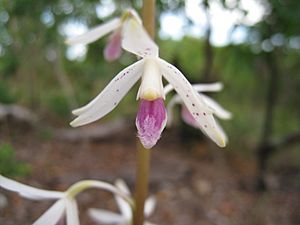Tropical hyacinth-orchid facts for kids
Quick facts for kids Tropical hyacinth orchid |
|
|---|---|
 |
|
| Dipodium stenocheilum in Charles Darwin National Park | |
| Scientific classification | |
| Genus: |
Dipodium
|
| Species: |
stenocheilum
|
| Synonyms | |
|
Dipodium punctatum var. stenocheilum (O.Schwarz) Rupp |
|
The tropical hyacinth-orchid (scientific name: Dipodium stenocheilum) is a special kind of orchid. It doesn't have leaves! This plant gets its food from other things in the soil, like dead plants. It only grows naturally in northern Australia. Most of the year, the plant is sleeping underground. But in summer, it grows a tall stem with up to twenty-five white flowers. These flowers have purple spots and a pretty purple "lip" part.
Contents
What Does It Look Like?
The tropical hyacinth-orchid is a plant that lives for many years. It has no leaves and grows from a tuber (a swollen underground stem, like a potato). It gets its food from fungi in the soil.
Most of the time, this plant is hidden underground. But in summer, it sends up a greenish-yellow flower stem. This stem can be 40 to 120 cm (about 1.5 to 4 feet) tall. It holds between three and twenty-five white flowers. Each flower has purple spots and is about 40 to 50 mm (about 1.5 to 2 inches) wide.
The flower parts are:
- The top petal (called the dorsal sepal) is 20 to 30 mm long.
- The side petals (lateral sepals) are a bit longer.
- The other petals are shorter than both sepals.
- All these parts are separate and lie flat or curve back a little.
The "lip" of the flower (called the labellum) is mauve (light purple) with darker marks. It is 15 to 20 mm long and has three parts. The middle part has a band of mauve hairs. These orchids usually bloom from November to March.
Who Named This Orchid?
The tropical hyacinth-orchid was first officially described in 1927. A scientist named Otto Schwarz wrote about it. His description was published in a science journal called Repertorium Specierum Novarum Regni Vegetabilis. The first plant he studied was found near Port Darwin in Australia.
The scientific name stenocheilum comes from two old Greek words. Stenos means "narrow" or "tight." Cheilos means "lip" or "rim." So, the name describes the narrow lip of the flower.
Where Does It Live?
You can find the tropical hyacinth-orchid in northern Australia. This includes the Northern Territory (like Melville Island), the Cape York Peninsula in Queensland, and the Kimberley area of Western Australia.
Some scientists think that the orchids found in Western Australia might actually be two different species. They have not been officially named yet. These are sometimes called the sandstone hyacinth orchid and the basalt hyacinth orchid.
How Does It Grow and Interact with Nature?
Like all orchids in its group, the tropical hyacinth-orchid is pollinated by native bees and wasps. This means these insects help the plant make seeds by carrying pollen from one flower to another.
Can You Grow It at Home?
It is very hard to grow leafless Dipodium orchids, like the tropical hyacinth-orchid, at home. This is because they need a special connection with tiny fungi in the soil to survive. It's almost impossible to create this exact relationship outside of their natural home.

